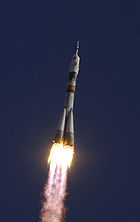| This article needs additional citations for verification. Please help improve this article by adding citations to reliable sources. Unsourced material may be challenged and removed. Find sources: "Vostok-L" – news · newspapers · books · scholar · JSTOR (December 2009) (Learn how and when to remove this message) |
 Vostok-L rocket Vostok-L rocket | |
| Function | Carrier rocket |
|---|---|
| Manufacturer | OKB-1 |
| Country of origin | USSR |
| Size | |
| Stages | Two |
| Capacity | |
| Payload to LEO | |
| Mass | 4,550 kilograms (10,030 lb) |
| Associated rockets | |
| Family | R-7 |
| Derivative work | Vostok-K |
| Launch history | |
| Status | Retired |
| Launch sites | Baikonur Site 1/5 |
| Total launches | 4 |
| Success(es) | 3 |
| Failure(s) | 1 |
| First flight | 15 May 1960 |
| Last flight | 1 December 1960 |
| Type of passengers/cargo | Korabl'-Sputnik |
| Boosters | |
| No. boosters | 4 |
| Powered by | 1 RD-107-8D74 |
| Maximum thrust | 970 kilonewtons (220,000 lbf) |
| Burn time | 120 seconds |
| Propellant | RP-1/LOX |
| First stage | |
| Powered by | 1 RD-108-8D75 |
| Maximum thrust | 912 kilonewtons (205,000 lbf) |
| Burn time | 310 seconds |
| Propellant | RP-1/LOX |
| Second stage | |
| Powered by | 1 RD-0105 |
| Maximum thrust | 49.42 kilonewtons (11,110 lbf) |
| Burn time | 390 seconds |
| Propellant | RP-1/LOX |
| [edit on Wikidata] | |
The Vostok-L (Russian: Восток meaning "East"), GRAU index 8K72 was a rocket used by the Soviet Union to conduct several early tests of the Vostok spacecraft.
It was derived from the Luna rocket, with a slightly enlarged second stage to accommodate the larger payload. and was a member of the Vostok family of rockets.
Launches
Four launches were conducted between 15 May and 1 December 1960 from Baikonur LC-1/5, three of which successfully reached orbit.
The first flight, on 15 May 1960, carried the Korabl-Sputnik 1 spacecraft. The second launched on 28 July, however one of the booster engines exploded during launch, causing the booster to separate prematurely, 19 seconds after launch. The rocket broke up 30 seconds after liftoff, killing the two dogs that were aboard the spacecraft. The third flight successfully placed Korabl-Sputnik 2 into orbit on 19 August, whilst the fourth and final flight orbited Korabl-Sputnik 3 on 1 December.
| Serial No. | Date | Payload | Result |
|---|---|---|---|
| L1-11 | 15.05.1960 | Korabl-Sputnik 1 | Success |
| L1-10 | 28.07.1960 | Korabl-Sputnik (2) | Failure |
| L1-12 | 19.08.1960 | Korabl-Sputnik 2 | Success |
| L1-13 | 01.12.1960 | Korabl-Sputnik 3 | Success |
The Vostok-L was replaced by an uprated version, the Vostok-K, which offered a greater payload capacity.
References
- ^ Wade, Mark. "Soyuz". Encyclopedia Astronautica. Archived from the original on 2010-01-07. Retrieved 2009-04-15.
- "Vostok". Gunter's Space Page. Retrieved 2023-10-22.
| Soviet and Russian launch vehicles | |
|---|---|
| Active | |
| In development | |
| Retired | |
| Cancelled (no launch attempts) | |
| R-7 rockets | |||||||||||
|---|---|---|---|---|---|---|---|---|---|---|---|
| Missiles |  | ||||||||||
| Launch systems |
| ||||||||||
| Launch sites | |||||||||||
| Launches | |||||||||||
| Engines | |||||||||||
| See also | |||||||||||